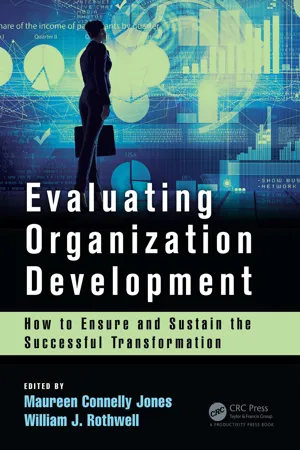1.1Introduction
1.2Chapter Overview
1.3Business Case for Evaluating Change
1.4Organization Development
1.5OD Intervention
1.6Participants in a Change Effort and Their Influence
1.7Intervention Models
1.7.1Action Research Model
1.7.2Appreciative Inquiry Model
1.8Organizational Readiness for Change
1.9Influential Forces in an Organization
1.10Employee Work Engagement
1.11Organizational Characteristics
1.11.1Organizational Culture
1.12Evaluation
1.13Evaluation of a Change Effort
1.13.1Phases of Evaluation
1.13.1.1Preintervention Evaluation
1.13.1.2Intraintervention Evaluation
1.13.1.3Postintervention Evaluation
1.14Maximizing Change Evaluation
1.14.1Internal Validity
1.14.2Evaluation Design
1.14.3Situational Factors
1.14.4Time Effects
1.15Chapter Summary
1.16Key Definitions
References
1.1Introduction
Organizational change exists as a result of dynamic environments. To achieve and sustain a competitive position in their market, organizations must consistently consider development through change. “The pressure for businesses to change is enormous and inexorable, mostly because the competition is changing, and so is the marketplace” (O’Rourke 2013, p. 169). Innovative and forward-looking organizations understand that an organization’s strategy and growth is dependent on its development through successful change efforts.
This success requires an organization to not only identify the right problem to address but also make informed choices as to how to correct the problem. However, this is not the end of the story. From a strategic perspective, organizations must also understand how to manage and evaluate change efforts as critical control and forward-looking learning experiences. Therefore, the evaluation of a change effort must examine whether (or not)
The proper opportunity for development was identified
The set objectives were independent and clearly stipulated
The correct participants were chosen and their impact understood
The intervention type was appropriate
The scope, scale, and orientation of the intervention addressed the situation
Further, evaluating the benefits and outcomes of change efforts aligns with the trend of measuring human resource activities and their return on investment. Stakeholders, including an organization’s decision makers, stockholders, and board of directors, are concerned with effective and cost-efficient programs and processes that align with corporate strategy and long-term goals. Whether short or long term in scope, narrow or broad in scale, or process or behavior oriented, a change effort is an activity that directly correlates to the organization’s strategy and goals and, therefore, the results must be evaluated to measure its value and success.
1.2Chapter Overview
This chapter will incorporate the following topics:
Further, a brief case study dramatically illustrates the critical nature of the evaluation process. Important terms are defined at the end of the chapter. Finally, the appendices provide a multiphase stakeholder analysis tool and an activity that illustrates the importance of setting specific, measurable, and independent objectives for the change effort and the evaluation process.
1.3Business Case for Evaluating Change
Because of market pressures, a critical responsibility of a hospital administrator is to seek ways to reduce costs without reducing or affecting patient services. In addition, to ensure quality services, they are charged with monitoring discharged patient’s outcomes such as hospital re-admittance rates and postrelease emergency care rates. For that reason, one administrator decided to focus on the redesign of patient discharge education in hopes of reducing costs. This function was currently being performed by high-salary clinical specialists, but a proposal was made that this task might be transferred to nurses, who are a less costly member of the hospital staff, allowing for a reduced number of specialists. Under this new protocol, nurses would receive discharge education training, ongoing support from trained staff, and standardized discharge procedures for each department to guide the process.
As this change had the potential to negatively affect patient care, it was determined that a small-scale study be used to test the potential for a larger change effort. The objectives of the study included (a) a reduction in costs related to discharge education redesign, (b) maintaining or improving discharge education quality, (c) maintaining or improving patient satisfaction with discharge education including follow-up care instructions, and (d) maintaining patient health with no increase in the need for patient re-admittance or emergency care in the first month after their discharge.
The hospital administrator determined that the efficacy of the change effort must be confirmed before implementing the change across all hospital departments; therefore, it was imperative that an evaluation of the study results was conducted. The benchmark for determining success in meeting the change effort objectives was the data obtained during the 6 months before the study.
The redesign was implemented across three departments over a 6-month period. Data for the study was gathered through questionnaires mailed to the discharged patients, phone interviews with patients, and hospital and emergency room admittance records for discharged patients under the new protocol. The questionnaires and interviews were conducted and the data were analyzed through a third party to ensure validity and reliability of the results. Items on the survey used rating scales to measure the patient’s perception of discharge-related services including the quality of the discharge education and the patient’s satisfaction with the discharge education, including follow-up procedures.
In the evaluation phase, the results of the study were compared with the 6 months of data obtained before the study. The data related to hospital re-admittance and emergency room care were not conclusive and a longer-term study was proposed. However, when the questionnaire data were analyzed, the outcomes were clear. While cost reduction related to payroll had been achieved, most other objectives were not met. Patient satisfaction decreased significantly in most areas. There were two areas where satisfaction increased; however, these were areas of special emphasis during training.
It was obvious to the administrator that evaluating the change effort had been enormously valuable and saved the hospital from making a mistake in redesigning these procedures to includ...
